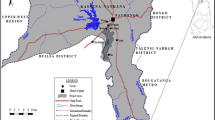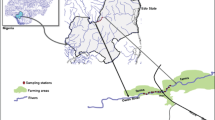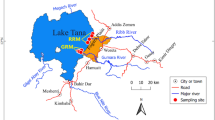Abstract
Residues of pesticides in fish farming productions from barrage ponds are seldom studied in spite of increasing health questionings and environmental concerns. The purpose of this study is to establish the pesticide contamination profiles of sediments and edible fish from five ponds in Northeastern France. Multi-residues method and liquid chromatography–tandem mass spectrometry analysis were used to quantify 13 pesticides (azoxystrobin, carbendazim, clomazone, diflufenican, dimethachlor, fluroxypyr, iprodion, isoproturon, mesosulfuron-methyl, metazachlor, napropamid, quizalofop and thifensulfuron-methyl). Ten sediments and 143 muscles samples were analysed, corresponding to two successive fishing campaigns (first fishing date and second fishing date (P2), about 1 year later) on five sites (noted C-0, C-25, C-45, C-75 and C-85 to express the increasing gradient of crop area). Isoproturon was present in all sediments samples (1.8–56.4 μg/kg dry weight). During P2 period, carbendazim was quantified in the fish of site C-0 (0.09 ± 0.02, 0.2 ± 0.1 and 0.17 ± 0.06 μg/kg wet weight (ww) for roach, carp and perch, respectively). Metazachlor was only quantified in perch of the site C-25 (0.13 ± 0.02 μg/kg ww). Concentrations of isoproturon were similar for the sites C-45 and C-75 with 0.4 ± 0.1 and 0.75 ± 0.06 μg/kg ww for carp and perch, respectively. Contamination of fish reflected generally concentrations in surroundings. Isoproturon was the most concentrated and its main source was water for perch while carp was exposed through both water and sediments, highlighting their life strategies in pond.

Similar content being viewed by others
References
Adámek Z, Sukop I, Moreno Rendón P, Kouřil J (2003) Food competition between 2+ tench (Tinca tinca L.), common carp (Cyprinus carpio L.) and bigmouth buffalo (Ictiobus cyprinellus Val.) in pond polyculture. J Appl Ichthyol 19(3):165–169
Banas D, Masson G, Leglize L, Pihan JC (2002a) Discharge of sediments, nitrogen (N) and phosphorus (P) during the emptying of extensive fishponds: effect of rain-fall and management practices. Hydrobiologia 472(1–3):29–38
Banas D, Masson G, Leglize L, Pihan JC (2002b) Temporal variations of sedimentation in shallow freshwater systems. Arch Hydrobiol Fund Appl Limnol 153(4):623–634
Banas D, Masson G, Leglize L, Usseglio-Polatera P, Boyd CE (2008) Assessment of sediment concentration and nutrients loads in effluents drained from extensively-managed fishponds in France. Environ Pollut 152(3):679–685
Banas D, Marin B, Skraber S, Chopin E, Zanella A (2010) Copper mobilization affected by weather conditions in a stormwater detention system receiving runoff waters from vineyard soils (Champagne, France). Environ Pollut 158:476–482
Bony S, Gaillard I, Devaux A (2010) Genotoxicity assessment of two vineyard pesticides in zebrafish. Int J Environ Anal Chem 90:421–428
Bostock J, McAndrew B, Richards R, Jauncey K, Telfer T, Lorenzen K, Little D, Ross L, Handisyde N, Gatward I, Corner R (2010) Aquaculture: global status and trends. Philos Trans R Soc Lond B Biol Sci 365(1554):2897–2912
Bruslé J, Quignard J-P (2001) Biologie des poissons d’eau douce européeens. Editions Tech & Doc Lavoisier, Paris
Burkhard LP, Cook PM, Lukasewycz MT (2010) Direct application of biota-sediment accumulation factors. Environ Toxicol Chem 29(1):230–236
Council of European Communities (1986) Council Directive 86/609/EEC of 24 November 1986 on the approximation of laws, regulations and administrative provisions of the Member States regarding the protection of animals used for experimental and other scientific purposes. http://europa.eu/legislation_summaries/environment/nature_and_biodiversity/l28104_en.htm. Accessed 20 Oct 2009
Devault A, Merlina G, Lim P, Probst J-L, Pinelli E (2007) Multi-residues analysis of pre-emergence herbicides in fluvial sediments: application to the mid-Garonne River. J Environ Monit 9:1009–1017
Devault A, Gérino M, Laplanche C, Julien F, Winterton P, Merlina G, Delmas F, Lim P, Sánchez-Pérez JM, Pinelli E (2009) Herbicide accumulation and evolution in reservoir sediments. Sci Total Environ 407(8):2659–2665
Di Giulio RT, Hinton DE (2008) The toxicology of fishes. Taylor, Boca Raton
Drozdzyński D (2008) Studies on residues of pesticides used in rape plants protection in surface waters of intensively exploited arable lands in Wielkopolska Province of Poland. Ann Agr Environ Med 15(2):231–235
FAO (Food and Agriculture Organization of the United Nations) (2007) Aquaculture—new opportunities and a cause for hope.http://www.fao.org/focus/e/fisheries/aqua.htm. Accessed 22 May 2010
France AgriMer (2009) Les chiffres clés de la filière pêche et aquaculture en France, édition 2009. Editions OFIMER. http://www.ofimer.fr/99_up99load/2_actudoc/1723d1_01.pdf. Accessed 22 May 2010
Gorbatiuk LO (2010) Physiological-biochemical response of fish to the pesticide effect (a review). Hydrobiol J 46:78–87
Hu G, Dai J, Mai B, Luo X, Cao H, Wang J, Li F, Xu M (2010) Concentrations and accumulation features of organochlorine pesticides in the Baiyangdian lake freshwater food web of North China. Arch Environ Contam Toxicol 58:700–710
Itavi (1999) La pisciculture d’étang française. Itavi Editions, Paris
Janjua MY, Gerdeaux D (2011) Evaluation of food web and fish dietary niches in oligotrophic Lake Annecy by gut content and stable isotope analysis. Lake Reserv Manag 27(2):113–125
John PJ, Prakash A (2003) Bioaccumulation of pesticides on some organs of freshwater catfish Mystus vittatus. Bull Environ Contam Toxicol 70:1013–1016
Konwick BJ, Garrison AW, Avants JK, Fisk AT (2006a) Bioaccumulation and biotransformation of chiral triazole fungicides in rainbow trout (Oncorhynchus mykiss). Aquat Toxicol 80(4):372–381
Konwick BJ, Garrison AW, Black MC, Avants JK, Fisk AT (2006b) Bioaccumulation, biotransformation, and metabolite formation of fipronil and chiral legacy pesticides in rainbow trout. Environ Sci Technol 40(9):2930–2936
Lazartigues A, Fratta C, Baudot R, Wiest L, Feidt C, Thomas M, Cren-Olivé C (2011a) Multiresidue method for the determination of 13 pesticides in three environmental matrices: water, sediments and fish muscle. Talanta 85(3):1500–1507
Lazartigues A, Wiest L, Baudot R, Thomas M, Feidt C, Cren-Olivé C (2011b) Multiresidue method to quantify pesticides in fish muscle by QuEChERS-based extraction and LC-MS/MS. Anal Bioanal Chem 400(7):2185–2193
Lazartigues A, Banas D, Feidt C, Brun-Bellut J, Thomas M (2012a) Pesticide pressure and fish farming in barrage pond in North-eastern France. Part I: sites characterization and water quality. Environ Sci Poll Res 19(7):2802–2812
Lazartigues A, Banas D, Feidt C, Brun-Bellut J, Gardeur J-N, Le Roux Y, Thomas M (2012b) Pesticide pressure and fish farming in barrage pond in northeastern France. Part III: how management can affect pesticide profiles in edible fish? Environ Sci Poll Res. doi:10.1007/s11356-012-0824-1
Le Bihan J, Font M (2008) Synthèse sur les zones humides françaises. Les étangs. Rapport janvier 2008. www.ifen.fr/zoneshumides/pages/ouvragesetrapports23.pdf. Accessed 10 June 2010
Lithourgidis AS, Dordas CA, Damalas CA, Vlachostergios DN (2011) Annual intercrops: an alternative pathway for sustainable agriculture. Aust J Crop Sci 5(4):396–410
Loganathan BG, Kannan K (1994) Global organochlorine contamination trends: an overview. Ambio 23(3):187–191
Loos R, Gawlik BM, Locoro G, Rimaviciute E, Contini S, Bidoglio G (2009) EU-wide survey of polar organic persistent pollutants in European river waters. Environ Poll 157(2):561–568
Mahboob S, Ghazala Sultana S, Al-Akel AS, Al-Balawi A-K, Ai-Misned F, Zubair M (2011) Pesticide residues in flesh of Cirrhinus mrigala collected from a commercial farm and river Chenab at Trimu Head. Jhang Pak J Zool 43(1):97–101
Marchand J, Tanguy A, Charrier G, Quiniou L, Plee-Gauthier E, Laroche J (2006) Molecular identification and expression of differentially regulated genes of the European flounder, Platichthys flesus, submitted to pesticide exposure. Mar Biotechnol 8:275–294
Martin JD (2009) Sources and preparation of data for assessing trends in concentrations of pesticides in streams of the United States, 1992–2006. US Geological Survey Scientific Investigations Report 2009-5062, Reston, Virginia. http://pubs.er.usgs.gov/publication/sir20095062. Accessed 26 April 2011
Nhan DK (2007) The role of a fish pond in optimizing nutrient flows in integrated agriculture–aquaculture farming systems. PhD thesis. Wageningen University
PPDB (2009) The Pesticide Properties Database (PPDB) developed by the Agriculture & Environment Research Unit (AERU), University of Hertfordshire, funded by UK national sources and the EU-funded FOOTPRINT project (FP6-SSP-022704). http://sitem.herts.ac.uk/aeru/footprint/index2.htm. Accessed 27 June 2012
Prein M (2002) Integration of aquaculture into crops–animal systems in Asia. Agr Sys 71:127–146
Rahman MM, Nagelkerke LAJ, Verdegem MCJ, Wahab MA, Verreth JAJ (2008) Relationships among water quality, food resources, fish diet and fish growth in polyculture ponds: a multivariate approach. Aquaculture 275(1–4):108–115
Reemtsma T, Jekel M (2006) Organic pollutants in the water cycle. Wiley, Weinheim
Roche H, Vollaire Y, Martin E, Rouer C, Coulet E, Grillas P, Banas D (2009) Rice fields regulate organochlorine pesticides and PCBs in lagoons of the Nature Reserve of Camargue. Chemosphere 75(4):526–533
Sauret N, Wortham H, Strekowski R, Herckès P, Nieto LI (2009) Comparison of annual dry and wet deposition fluxes of selected pesticides in Strasbourg, France. Environ Poll 157(1):303–312
Sun F, Wong SS, Li GC, Chen SN (2006) A preliminary assessment of consumer’s exposure to pesticide residues in fisheries products. Chemosphere 62:674–680
Tracey GA, Hansen DJ (1996) Use of biota-sediment accumulation factors to assess similarity of nonionic organic chemical exposure to benthically-coupled organisms of differing trophic mode. Arch Environ Contam Toxicol 30(4):467–475
Vecchio Y, Bourbon B, Valadou B (2009) Aquaculture, introductions and transfers, and transgenics, focus area report. http://www.onema.fr/IMG/pdf/RapportFARaquaculture.pdf. Accessed 24 Oct 2011
Water Agency Rhine-Meuse (2011) Suivi des pesticides dans les eaux souterraines du bassin Rhin-Meuse-situation en 2009. http://www.eau-rhin-meuse.fr/tlch/qualité%20eau/PT%204%20Rapport_suivi_phytos_eau_sout_2009_V4.pdf. Accessed 27 June 2012
WHO (1993) Environmental Health Criteria 149: Carbendazim, International Program on Chemical Safety. http://www.inchem.org/documents/ehc/ehc/ehc149.htm. Accessed 27 June 2012
WHO (2003) Health risks of persistent organic pollutants from long-range transboundary air pollution. WHO Regional Office for Europe Publication, Copenhagen. http://www.euro.who.int/document/e78963.pdf. Accessed 12 Jan 2009
Zhong Y, Power G (1997) Fisheries in China: progress, problems, and prospects. Can J Fish Aquat Sci 54(1):224–238
Acknowledgments
This work is supported by the “Agence de l’Eau Rhin-Meuse” and the “Zone Atelier Moselle”. Authors would thank all people who had lent help during the campaigns and in particular: fish farmers S. Betoulle, V. Felten, S. Paris-Palacios and A. Vettier coming from eco-toxicology laboratory of the Reims University (France); A. Abdulfatah, M.-D. Castets, A. Iuretig, Y. Ledoré, C. Messana and A. Trabelsi of UR-AFPA staff. R. Baudot, C. Fratta and L. Wiest from UMR 5280 ISA are also sincerely acknowledged for their analytical assistance.
Author information
Authors and Affiliations
Corresponding author
Additional information
Responsible editor: Philippe Garrigues
Rights and permissions
About this article
Cite this article
Lazartigues, A., Thomas, M., Cren-Olivé, C. et al. Pesticide pressure and fish farming in barrage pond in Northeastern France. Part II: residues of 13 pesticides in water, sediments, edible fish and their relationships. Environ Sci Pollut Res 20, 117–125 (2013). https://doi.org/10.1007/s11356-012-1167-7
Received:
Accepted:
Published:
Issue Date:
DOI: https://doi.org/10.1007/s11356-012-1167-7




